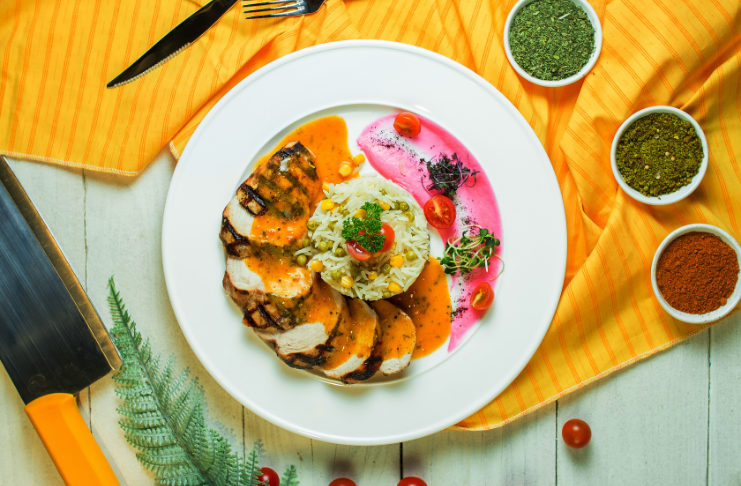Picture this– A server carries food you plated towards a table. As the server presents the customers with their plates, conversations pause mid-conversation, an audible gasp and they pull out their phones for a photo and click! This moment, that dish, your art is captured forever.
Food presentation is an art form that can elevate even the simplest dish into a memorable dining experience. We often hear that “we eat with our eyes first”—a concept that underscores the critical importance of visual appeal in what makes food delicious. Chefs and restaurant operators increasingly recognize that mastering creative presentation techniques provides a significant competitive advantage in today’s experience-driven market.
The implementation of creative presentation techniques directly correlates with increased customer satisfaction, enhanced social media visibility, and strengthened brand recognition.
This comprehensive guide explores several food presentation techniques that will transform your culinary creations from merely delicious to visually spectacular.
The Psychology Behind Food Presentation
Before diving into the specifics, it’s crucial to understand why these creative food presentation tips and techniques play a vital role in the dining experience.
Studies reveal that diners naturally gravitate toward beautifully plated dishes—a phenomenon known as gustatory aesthetics. This principle emphasizes how visual appeal directly influences our taste buds’ perception.
When food presentation techniques showcase art and precision, diners anticipate a more elevated experience. Interestingly, this expectation enhances the actual flavor perception, proving that presentation isn’t just about looks—it shapes the entire culinary experience.
The same dish can taste remarkably better simply because of how it’s plated. When the customer takes the first bite, with their eyes shut, a slight nodding and the look of discovery on their face you witness a rare moment of dining transcendence.
That’s why top chefs spend years mastering plating techniques. A well-executed food plating doesn’t just make a dish look appetizing; it sets the stage for an unforgettable dining experience.
Essential Elements of Outstanding Food Presentation
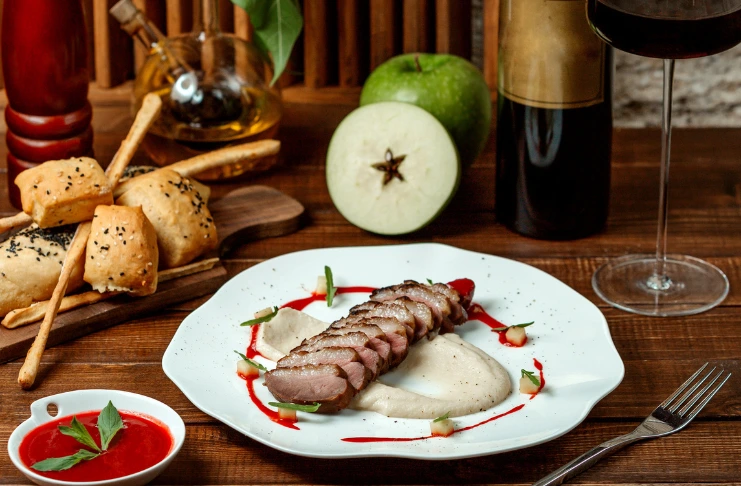
1. Color Contrast and Complementation
One of the most fundamental creative food presentation techniques is the strategic use of color. Vibrant, contrasting colors add visual appeal and make a dish instantly more enticing.
Professional chefs often develop a color scheme for their dishes. By choosing complementary or contrasting colors, they create visually striking plates that enhance the overall dining experience.
2. Texture Variation
Texture contrast is another essential element of food plating and presentation techniques. A memorable dish combines multiple textures—crispy, creamy, chewy, and crunchy—to engage both the palate and the eyes.
Beyond taste, textures serve as visual components that add depth to a plate. Various cutting techniques, smooth purées, and crunchy edible garnishes contribute to a dish’s textural landscape, making it more dynamic and engaging.
3. Balance and Proportion
The most effective creative plate presentation techniques focus on balance and proportion. A well-plated dish considers visual weight alongside portion size, ensuring that each component contributes to a harmonious composition.
Professional chefs often use the golden ratio or the rule of thirds to create visually balanced plates. These classical composition principles provide diners with an intuitive sense of harmony, making the presentation feel effortless yet refined.
5 Food Presentation Techniques Every Chef Should Master
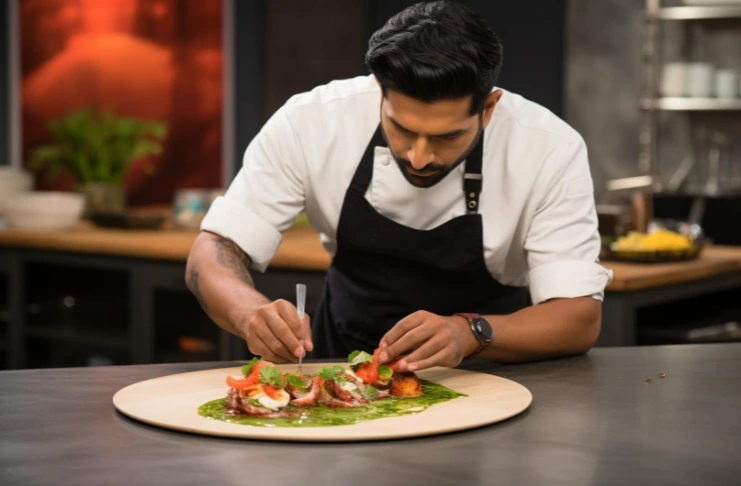
5 food presentation techniques that you should swear by:
1. Negative Space Utilization
When it comes to food presentation, more isn’t always better—despite what beginners often assume. One of the most sophisticated creative food presentation techniques is the strategic use of negative space or the empty areas on a plate.
Overcrowding a plate diminishes its visual appeal. Instead, they use negative space to frame and emphasize each element, allowing the dish to stand out with elegance. This approach not only enhances aesthetics but also guides the diner’s eye to fully appreciate every component.
2. Architectural Plating
Flat, one-dimensional plates rarely excite diners. One of the most impactful creative presentation techniques in modern cuisine is adding height to a dish. Elevating elements on the plate instantly creates drama, depth, and visual intrigue, transforming an ordinary meal into a stunning masterpiece.
However, while height enhances presentation, stability is key. Your food architecture should be sturdy enough to maintain its form from kitchen to table, ensuring both beauty and balance in free form with every bite.
3. Artistic Sauce Application
Sauce application is one of the most distinctive creative presentation techniques, offering endless opportunities for artistic expression. Elevate your plating process with these refined methods:
- Drizzling: Use a squeeze bottle or spoon to create elegant lines or intricate patterns.
- Dotting: Arrange small, precise dots of sauce in intentional designs for a modern touch.
- Brushing: Use a food-safe brush to paint sweeping strokes for a bold, artistic effect.
- Pooling: Form a smooth, even base of sauce beneath the main ingredients for a polished, sophisticated look.
Let the plate be your canvas and paint!
4. Precision Cutting Techniques
The way ingredients are cut plays a crucial role in food presentation, influencing both aesthetics and texture. Precision and consistency not only showcase technical skill but also create a sense of visual harmony on the plate. Different cutting styles evoke different effects:
- Brunoise: Tiny, uniform cubes that exude refinement and meticulous attention to detail.
- Chiffonade: Delicate, ribbon-like strips of herbs or greens that add elegance and texture.
- Tourné: Classic, football-shaped vegetable cuts that highlight traditional culinary training.
- Oblique Cuts: Diagonal slices that enhance geometric appeal and maximize surface area for flavor absorption.
5. Thoughtful Garnishing
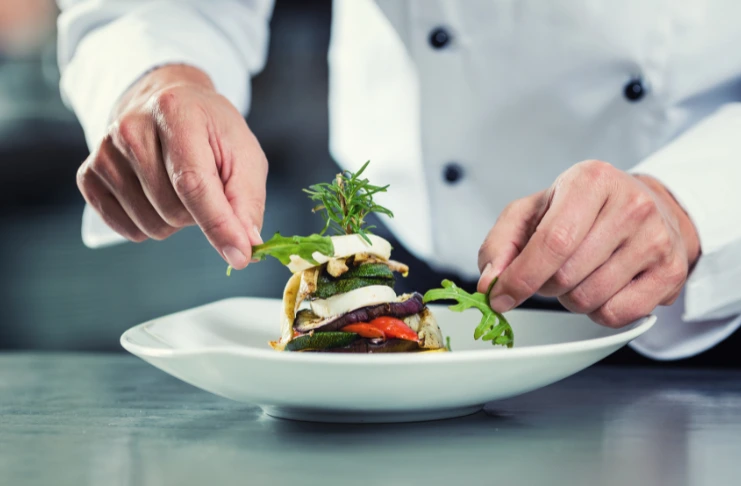
Garnishes should never be an afterthought. The most impactful creative food presentation techniques treat garnishes as essential elements, enhancing both visual appeal and flavor rather than serving as mere decorations. Modern chefs carefully select garnishes that elevate the dish in multiple ways:
- Complement the dish’s flavors for a harmonious taste experience.
- Add textural contrast to keep every bite interesting.
- Introduce vibrant colors to enhance visual appeal.
- Be fully edible and enjoyable, never just for show.
- Reflect the dish’s ingredients, offering a hint of what’s inside.
6. A bonus point: Digital Dining
The revolution in creative presentation techniques goes beyond the plate—it extends to how menus are designed and presented. QR code menus have transformed the dining experience, seamlessly complementing thoughtful food presentation.
With digital menus and QR code ordering, restaurants can showcase high-quality food photography, allowing diners to preview dishes before ordering. This visual element enhances the appeal of creative presentation techniques, making meals more enticing. In fact, data analysis reveals that customers are 30% more likely to order dishes when they can see them first.
EXPERT INSIGHT
| In the competitive culinary world, food presentation plays a pivotal role in distinguishing a chef’s creations. Chef Shantanu Gupte, founder of Shiifu Kitchen and Chef Shan Cakes, emphasizes that plating is an art form that provides uniqueness to dishes. He believes that visual appeal significantly impacts a diner’s experience, as it sets expectations before the first bite. By meticulously arranging elements on the plate, chefs can enhance the perceived taste and overall enjoyment of their food. |
Tools That Enhance Creative Food Presentation
Having the right tools dramatically expands your food presentation capabilities and precision.
- Precision tools: Tweezers, offset spatulas, and small paint brushes for detailed work, essential for modern creative presentation techniques.
- Molds and rings: Stainless steel shapes for structured presentations.
- Squeeze bottles: For precise sauce application and intricate designs, foundational to many creative presentation techniques.
- Microplane graters: For fine garnishes and delicate textures.
- Culinary torches: For selective caramelization and textural contrasts, an increasingly common tool for implementing creative presentation techniques.
Investing in quality presentation tools allows for greater technical precision and expanded creative possibilities in the kitchen.
Digital-Age Food Presentation: Techniques for Social Media
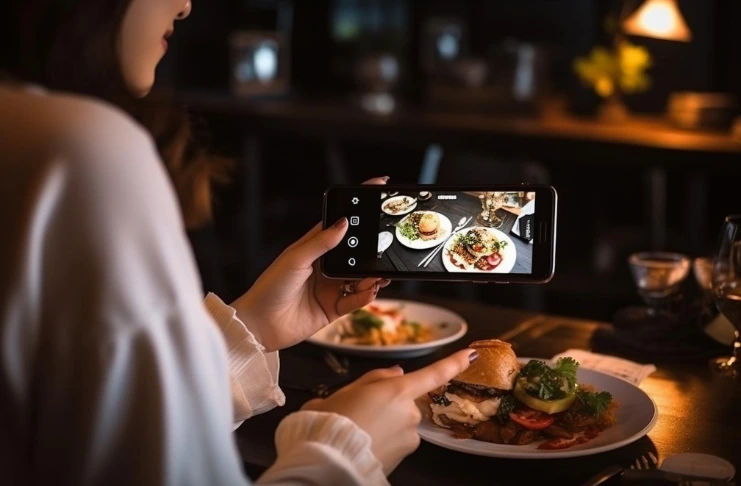
In today’s social media-driven world, here are a few tips to consider that can act as the cherry on top of your creative presentation techniques:
- Lighting Considerations: Great food photography thrives on natural lighting. Avoid harsh direct sunlight or artificial lighting with a yellow tint, and let the camera (a good one, obviously) do its job.
- Composition for Photography: Not all food presentation techniques translate well on camera. Some plating styles that look stunning in person may not work for Instagram’s top-down shots or Zomato’s food listing images. Always consider the best angles for photography, ensuring your dishes look irresistible online.
- Props and Styling: The right background, tableware, and props can elevate your food presentation, making it more visually engaging. Using textured linens, stylish plates, and complementary elements can be a good solution as they create a captivating scene that enhances your creative food presentation techniques and drives customer engagement. On food delivery platforms, professional images reinforce brand identity, attract more customers, and create a competitive edge.
By integrating commercial and creative presentation techniques, restaurants can boost online engagement, drive more orders, attract customers and build a stronger brand presence—whether through social media buzz or higher conversions on food delivery apps
Seasonal Approaches to Creative Food Presentation
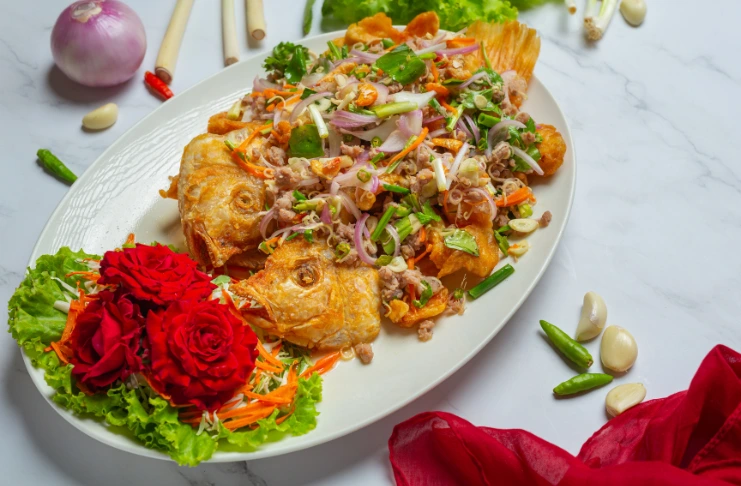
Adapting food presentation techniques to match the seasons doesn’t just enhance aesthetics—it creates memorable dining experiences that keep guests coming back. Embrace seasonal plating, and you can make dishes feel fresher, more authentic, and visually stunning. Let’s explore how to refine restaurant plating to match each season.
- Spring: Fresh & Vibrant
Let’s start with the current season of flowers– spring. Spring is all about renewal and freshness. Enhance your seasonal creative presentation techniques with the following:
- Bright green hues from herbs and microgreens
- Delicate garnishing techniques using edible flowers
- Light, airy plating styles for a fresh look
- Drizzles of herb-infused oils for color and elegance
These elements bring the crisp, lively feel of spring to the plate, making every dish a visual delight.
- Summer: Bold & Lively
Summer dining should be vibrant, flavorful, and fun. Try these creative food presentation tips and techniques:
- Eye-catching, bold colors from seasonal fruits and veggies
- Abundant use of fresh herbs for aroma and appeal
- Restaurant plating with shareable, family-style dishes
- Casual yet artistic plating styles that feel effortless
Guests crave bright, sun-kissed dishes in the summer, and seasonal plating helps you capture the season’s energy on every plate.
- Autumn: Warm & Rustic
Fall brings heartier dishes and deep, comforting flavors. Enhance your food presentation techniques with the following:
- Rich, earthy tones like deep reds, oranges, and browns
- Rustic serving vessels like wooden boards or stone plates
- Height and structure for a satisfying, abundant feel
- Deep, concentrated sauces for bold culinary aesthetics
With autumn-inspired restaurant plating, you create a cozy, welcoming atmosphere that reflects the season’s warmth.
- Winter: Elegant & Striking
Winter calls for sophisticated, dramatic plating. Elevate your seasonal food presentation with these creative presentation techniques:
- White-on-white aesthetics for a sleek, modern feel
- Precise, architectural plating styles for refined elegance
- Luxurious garnishing techniques like shaved truffles or gold leaf
- Deep contrasts and concentrated flavors for intensity
Winter plating should feel indulgent and refined, mirroring the beauty of crisp, frosty landscapes.
Bringing It All Together: Practice Makes Perfect
Mastering creative food presentation techniques takes practice, observation, and refinement. It is a science and an art that is always changing due to shifting aesthetic tastes, technological advancements, and cultural influences. Here are practical steps to elevate your plating techniques and create visually stunning dishes.
Practice Plating Exercises: Set aside time specifically for plating technique practice. Try plating the same dish multiple ways and experimenting with different creative food presentation techniques. Play with plate composition, sauce application, and height variation until you find the most aesthetic food presentation for each dish.
Taste is still the most important factor, even though visual impact is important. Creative food presentation techniques transform excellent cooking into memorable culinary experiences. Dining is genuinely unforgettable when culinary mastery and aesthetic appeal come together.
Study and Analyze: Examine plates in fine-dining restaurants, cookbooks, and social media. Look at color balance, negative space, texture contrast, and garnish placement to understand what works best.
Document Your Progress: Photograph your plates and build a visual journal of your evolving presentation style. Keeping a record helps track improvements and refine your food plating techniques over time, leading to a more polished and professional dining experience.
Embrace Feedback: Constructive feedback is invaluable. Whether from diners, fellow chefs, or food enthusiasts, outside perspectives can highlight blind spots in your food presentation techniques. Small adjustments can make a big difference in how your dishes are perceived.
Frequently Asked Questions
1. What is a creative way to make a presentation?
Use height, negative space, and contrasting colors to create visual interest on and around the plate. Incorporate unexpected elements like edible flowers or herbs, and experiment with sauce application techniques such as drizzling or painting sauces on white plates rather than simply pouring them over the dish.
2. What is the 5 5 5 rule for better presentation?
The 5 5 5 rule recommends using no more than five elements per plate, allowing at least 5mm of space between components, and taking at least 5 minutes to thoughtfully plan your plating design before executing it. This creates balance and prevents overcrowding.
3. What is the 10/20/30 rule in the presentation?
In food presentation, the 10/20/30 rule suggests using no more than 10 individual components, allowing 20% of the plate as negative space, and ensuring that 30% of your plated food visual impact comes from color contrast. This creates balanced, visually appealing dishes.
4. What is food presentation called?
Food presentation is professionally known as “plating” or “food styling.” It’s the culinary art of arranging and decorating food to enhance its aesthetic appeal and create a more enjoyable dining experience.
5. What are the 5 techniques in food presentation?
The five key food presentation techniques are strategic use of negative space, creating height and dimension, artistic sauce application, precision cutting techniques, and thoughtful garnishing. These fundamentals form the foundation of professional plating.
6. What are the 5 importance of food presentation?
Food presentation: 1) enhances perceived flavor through visual appeal, 2) demonstrates care and professionalism, 3) creates memorable dining experiences, 4) communicates the restaurant business’ cultural and stylistic values, and 5) increases the perceived value of dishes, justifying premium pricing.
7. What are the 5 guidelines for plating?
The five essential plating guidelines are: maintain appropriate portion sizes, create a clear focal point, use the plate as a frame (negative space), consider the flow and movement across the plate, and ensure all elements of finished plate are placed with intention rather than randomly.
8. What is the Nordic look technique?
The five essential plating guidelines are: maintain appropriate portion sizes, create a clear focal point, use the plate as a frame (negative space), consider the flow and movement across the plate, and ensure all elements are placed with intention rather than randomly.
9. How to make a good food presentation?
Use balance, contrast, and symmetry to create an appealing look. Choose the right plate size, ensure proper portioning, and add height for dimension. Fresh garnishes, clean plating, and thoughtful color combinations enhance visual appeal.
10. How do you present a food presentation?
Arrange food with care, using negative space to highlight key elements and maintain a clean, elegant look. Consider color contrast, texture variety, and layering techniques for depth. A well-placed sauce drizzle or garnish can add a final artistic touch.
11. What is a typical food presentation?
A well-plated dish features an organized composition with complementary colors and textures. It often includes a protein, starch, vegetable, and garnish, arranged in a visually balanced way. The goal is to make the dish look as appetizing as it tastes.
12. What is the artistic way of presenting food?
Treat the plate as a canvas by using sauces for drizzles or artistic streaks, incorporating edible flowers for color, and playing with unique serving styles. Experiment with textures, asymmetry, and geometric patterns for a modern, visually stunning effect.


